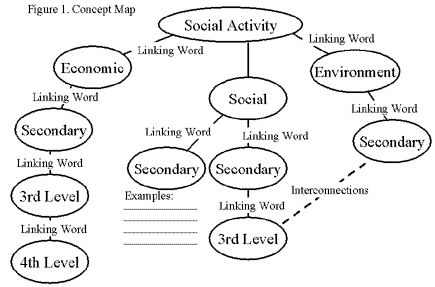

A hands-on group activity that helps participants see the effects of a local activity on the economy, society, and environment.
Purpose
To help participants view a local activity with an eye toward the three components of sustainability - economy, society, and environment.
Group size: 12 to 36 participants.
Time Needed: 1 to 1 1/2 hours.
Materials
- Three large sheets of paper for each group.
- Tape.
- One marking pen per participant.
- Extension: chalkboard and chalk.
Directions
- Divide your participants into groups of 3 to 6 people.
- Ask each group to identify a local, annual activity (e.g., festival, parade, or sporting event).
- Construct a concept map using this activity as the focal point (see Figure 1 below).

- Ask participants to think of ways the activity affects the local economy, the society, and the environment. Participants should write these primary factors on the paper and use connecting lines and words to show relationships (see Figure 2).
- Ask participants to identify secondary factors that affect or are affected by the primary factors.
- Identify third- and fourth-level factors and beyond, if possible.
- Using another sheet of paper, repeat Steps 3 to 6 for global factors that affect or are affected by the local activity.
- Prepare a chart on the remaining sheet of paper. Write the headings "Environment," "Economy," and "Society" across the top. Write "Local" and "Global" on the left side of the page (see Figure 3 below).
Figure 3.
|
Environment
|
Society
|
Economy
|
|
| Local |
Fertilizer
Use |
Public
Health
Education Landmarks Heritage Culture Migrant Workers Events Values |
Tourism
Shipping Service Industry Government Subsidy Seasonal Jobs Private Support Taxes Property Values |
| Global |
Acid
Rain
Ozone Depletion Logging Fishing Air |
Source
Community
Workers Child Labor Disease Poverty Government |
Big
Business
International Trade Agreements Farming Wages Cost of Living |
- Instruct participants to write factors from both concept maps on the
chart where appropriate. The results should indicate that the factors
reflect society, economy, and environment, both locally and globally.
Our local actions can have global impacts. Sustainable development means balancing the environment, society, and economy now and in the future, beginning locally.
Extension
- Begin a discussion of the local concept map. Ask each group to identify
a negative trend in the community (e.g., increased population, housing
shortage, poorer living conditions).
How many years can this trend continue before the situation becomes intolerable?
Should action be taken now to counteract this trend so future generations enjoy the same quality of life found in the community today?
Can the quality of life be improved now and for the future? How?
- Ask the group to identify a local natural resource depleted by human
activity and write it on the chalkboard. As a group, create a concept
map of probable factors, both local and global, that a shortage
of this resource may affect, create, or necessitate.
- Discuss the concept map. What does it imply for your community?
Return to Top | Next section: Envisioning a Sustainable Future